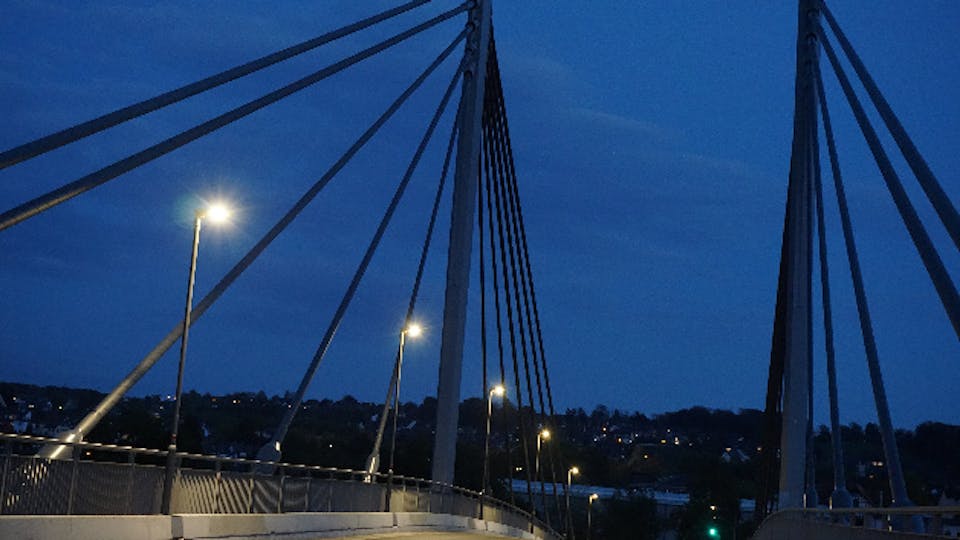
The new Kampmann Bridge in Essen made special demands on the lighting, as strict nature conservation requirements had to be taken into account. With the help of Doppler radar sensors, they could be met.
According to the nature conservation directive of the European Union, street lighting must be switched off overnight every year from the beginning of March to the end of October. In winter, the lighting should only be active when it is really needed.
But that's not all: the lighting should be able to differentiate in detail whether pedestrians, cyclists or motor vehicles are moving on the bridge and adjust the light level accordingly. Also, only the area of ??the street that is relevant for the pedestrian or the driver should be illuminated. The light should be switched off behind him. How far the road is illuminated in the direction of movement depends on the respective speed. In addition, the planners wanted a reliable system that could not be deceived, for example on movements caused by wind.
“The decisive factor was the flexible configuration of the lighting in order to comply with the requirements for nature conservation. The animals should not be disturbed or irritated, so it was important to be able to control the individual lights individually, ” says Sven Dressel, managing director of AEC Illuminazione in Neu-Anspach, who commissioned the installation of the lighting along the road over the new bridge had received food from the city. It consists of 68 intelligent 52 W standard luminaires of type ITALO from AEC in combination with the radar sensor from Comlight.
The Doppler radar sensors from Comlight are of decisive importance: they can be used to precisely record movements and the dynamically switched light appears inconspicuous and natural. Working only with infrared sensors would not be enough, because these sensors do not precisely record movements and cannot differentiate between people, animals and vehicles. In addition, it can be difficult to capture a thermal signature - from cyclists, for example - in winter. AEC therefore decided to use Comlight's Doppler radar sensors. Because it can determine the direction and speed of an object, as well as its size. In this way, the distinction between motor vehicle, cyclists or pedestrians can be reliably carried out.
In addition, the entire system is scalable, so additional systems can later be managed centrally via a cloud system without much additional effort, which was the city's wish from the start. In addition, it is manufacturer-neutral and can be used with all lights from other manufacturers that have a standardized Zhaga interface according to the D4i standard. The networking of all sensors via an 868 MHz mesh network results in a very low failure rate, even with relatively large mast spacings of up to 50 meters.
The lamps are individually controllable. Therefore, a different number of lamps can be switched on as required. Depending on the speed of the object or the person, distances of different lengths can be illuminated. Drivers and pedestrians always see a sufficiently large area illuminated in front of them so that the dynamically switched light is not recognized as such and therefore cannot be perceived as annoying.
To prevent the lights from reacting to movements that are not triggered by traffic and therefore do not require lighting, the sensors have artificial intelligence on board that filters out such movements. "If, for example, a tree moves in the wind in the sensor field of view, the artificial intelligence recognizes in a very short time that this is not an object that is moving and accordingly does not switch the lighting on," says Sven Dressel.
To simplify the installation of the street lighting, the Comlight sensors are equipped with a Zhaga connector. The interface specification makes it possible, among other things, to install the sensors within minutes or, if necessary, to replace them quickly. If desired, the luminaires can be networked and connected to the Internet, for example to record and evaluate energy consumption, light duration, frequency of use and other data.
In addition to the street lighting of the Kampmann Bridge in Essen, AEC has also successfully installed intelligent street lighting with radar sensors from ComLight in other cities, including Fulda, Fürth and Passau. In addition to saving energy, the systems also contribute to traffic safety and nature conservation.

Original article:
Partner:
AEC ILLUMINAZIONE GMBH
Map: